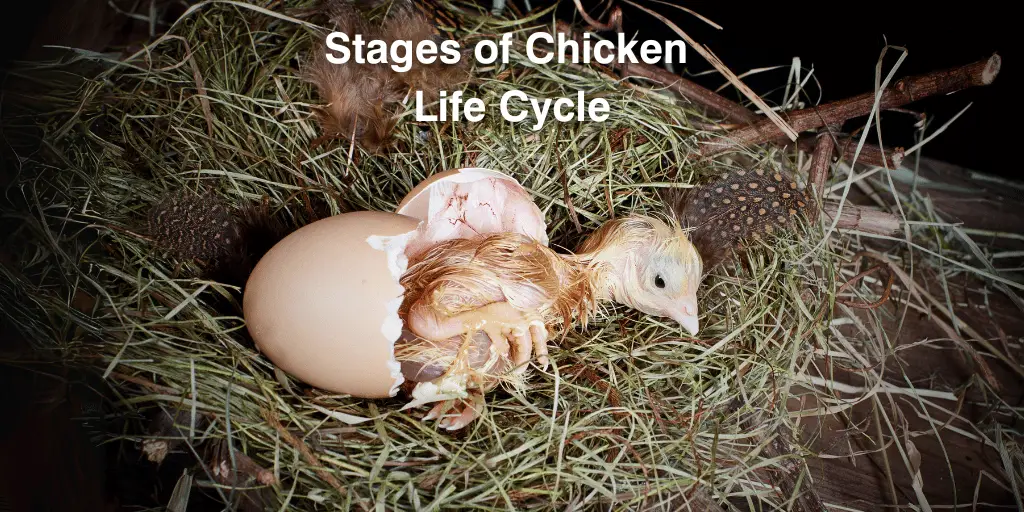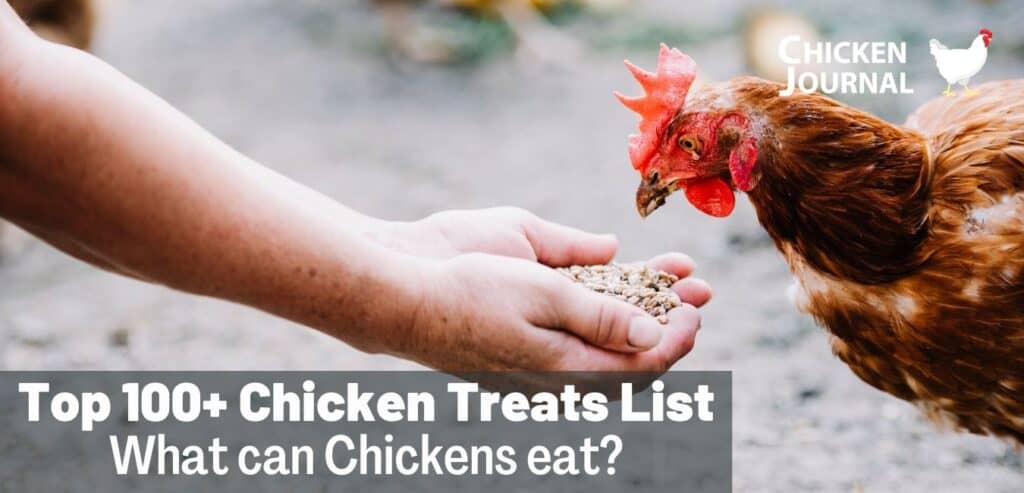What are the stages of the chicken life cycle? How do chicken eggs become adult hens or roosters?
You can better care for chickens by understanding their life cycle.
This blog post covers the four main stages of life chickens go through, from egg to adulthood.
Chickens change drastically from the egg phase to the long adult chicken phase.
The first step, the “Hatching Stage,” will examine how newborn chicks hatch and survive.
Next is the “Brooding Stage,” when chicks need a mother hen or a brooder for warmth and protection.
Chickens reach their “Juvenile Stage,” a vital time of rapid growth and skill development in pullets and cockerel.
We shall conclude with the “Adult Stage,” where hens and roosters mature and finish their reproductive cycle.
The four chicken life cycle stages explain their growth and development.
Let’s look at these major stages of the chicken life cycle.
Understanding the Chicken Reproduction Cycle
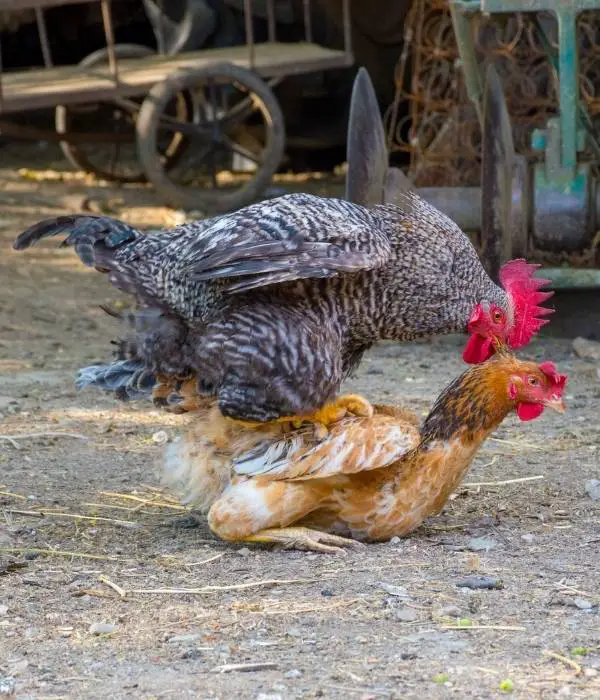
The chicken reproductive cycle is a multi-stage process. This cycle requires knowing how chicken reproductive organs make eggs.
Chicken reproduction begins with the development of the reproductive system.
Older chickens have larger ovaries and oviducts. These organs help lay and care for eggs.
When roosters mate with hens, their sperm fertilizes the egg in the oviduct. The fertilized egg travels through the oviduct.
Different eggshell layers are added as the fertilized egg moves through the oviduct. The embryo is protected and supported by these layers.
Hens lay entirely developed eggs. In the chicken reproduction system, the egg-laying cycle restarts after 24–26 hours of laying.
Also read: How Many Eggs Does A Chicken Lay A Day?
Egg Fertilization Process in Chicken Reproductive Cycle
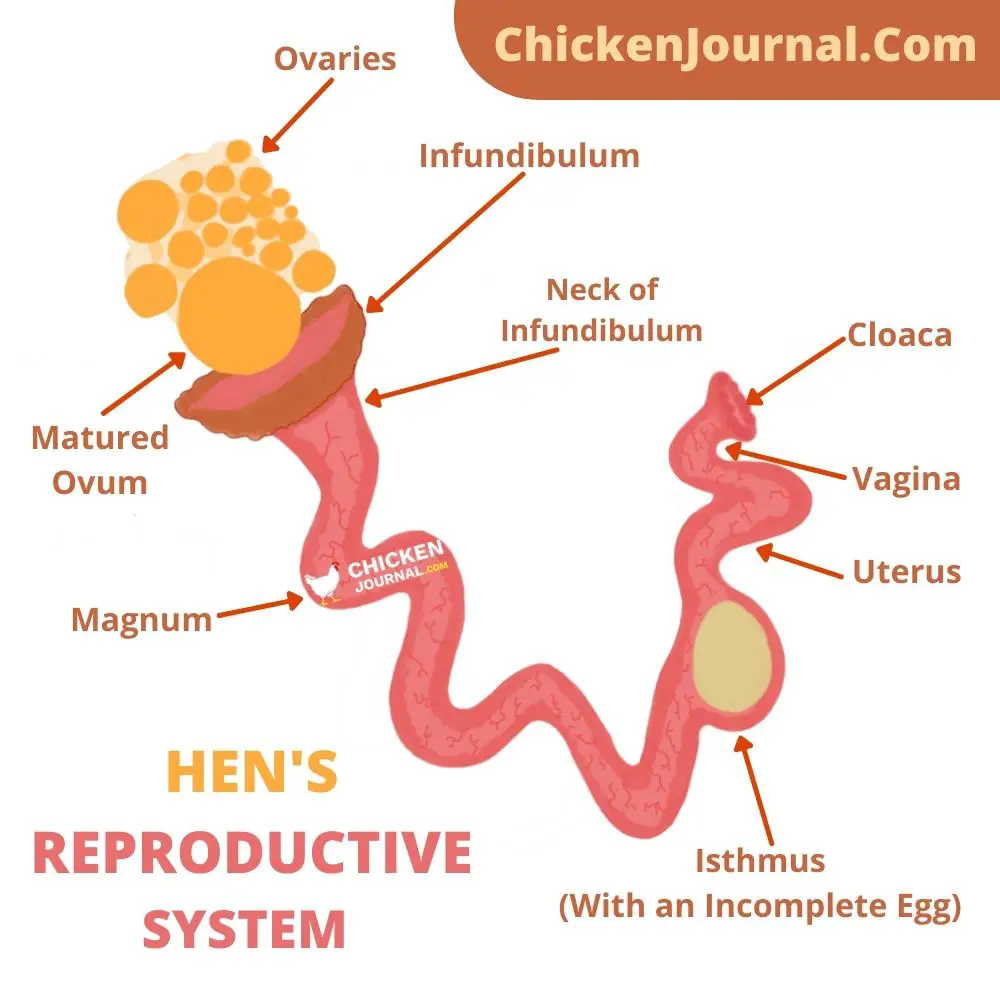
Egg fertilization is one of the crucial stages of the chicken life cycle. This process marks the beginning of a new life.
Ovaries
A hen’s reproductive system begins with the ovaries. Many thousands of underdeveloped eggs are in these ovaries.
The hen’s ovaries contain all her ova from birth. The ovaries are essential for egg production.
Ovulation
An egg yolk develops from an ova in the ovaries periodically. The process is called ovulation.
After the ovary releases the developed egg yolk, it enters the oviduct’s infundibulum area.
Infundibulum
At the infundibulum, fertilization occurs.
When the ovary releases sperm during mating, the infundibulum covers the mature egg yolk with sperm.
Fertilization occurs when rooster sperm meets egg yolk.
Magnum
The fertilized egg yolk enters the magnum, the second oviduct part.
The magnum contains egg white (albumen), which nourishes and protects the embryo.
Varying layers of albumen have different consistencies.
Isthmus
The egg enters the isthmus, the third oviduct part, from the magnum.
Here, eggs get their inner and outer shell membranes. These membranes protect and shape the embryo.
Shell Gland (Uterus)
The egg enters the oviduct’s fourth part, the shell gland or uterus. The shell gland deposits a strong calcium carbonate shell around the egg.
This shell shields and supports the embryo. Duration in the shell gland determines eggshell thickness and quality.
Chicken’s V@gina
An internal lubricant fluid coats the egg before placing it in the v@gina.
The egg exits the hen through her cloaca, her reproductive and excretory orifice.
From ovulation to egg laying, hens take 24–26 hours.
When the mating sperm meets the mature egg yolk in the infundibulum, egg fertilization occurs.
The egg will pass through the oviduct, which does not hatch into chicks if not fertilized. That’s why chickens can lay eggs without a rooster.
Also read: Complete difference between rooster and hen
Embryo Stage or Hatching Stages of The Chicken Life Cycle
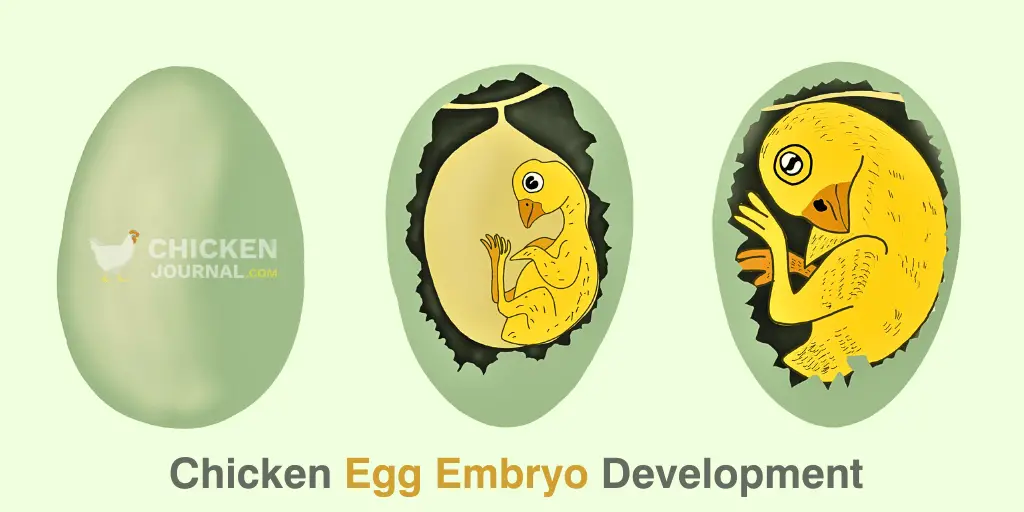
The embryo stage is an essential part of the chicken life cycle. From egg to hatch, the chick develops in 21 days.
A broody hen or an incubator incubates the egg.
Day 1:
The embryo develops from fertilization on day 1.
A zygote forms when rooster sperm fertilizes egg yolk.
The zygote divides into a multicellular blastoderm.
Thereafter, the single-cell embryo feeds on egg yolk to divide.
Day 2:
The blastoderm grows and spreads across the yolk.
In his stage tthe embryo develops into three layers.
The ectoderm, mesoderm, and endoderm will comprise tissues and organs.
Day 3:
Rapid cell division continues, complexing the embryo.
The blastoderm’s primitive streak thickens and is vital to gastrulation (creating the three germ layers).
Day 4:
The three germ layers arise during gastrulation.
Formation of the amnion, a fluid-filled sac that shields the embryo.
Day 5:
The embryo becomes longer.
As blood arteries form, the heart begins to form.
The yolk sac, which feeds the embryo, grows.
Day 6:
The neural tube (nervous system) and digestive system begin to develop during organogenesis.
Furthermore, the growing heart stabilizes blood circulation.
Day 7:
Veins and arteries form to deliver nutrition and oxygen to the embryo.
Wing and leg bud’s form.
Feather follicles, eye and beak prominently develop.
Day 8:
Tail forms.
Liver blood cell production begins.
Organs mature as the embryo grows.
Day 9:
The beak grows, and the head changes.
Ear development begins.
The feather follicles continue to grow.
Day 10:
Liver, kidney, and respiratory organ development continues.
Continued feather and beak growth.
The embryo may move involuntarily.
Day 11–14:
The embryo grows down feathers.
Wing and leg development continues.
The beak, eyes, and feathers enlarge.
Day 15-18:
Down feathers develop and cover the body.
The chick moves inside the egg, possibly facing the air cell.
Internal organs mature to prepare for hatching.
Day 19–21:
The large end air cell grows as the chick consumes oxygen from the egg.
The chick positions itself in the egg to hatch.
Day 21:
The chick hatches after making a pip or hole in the eggshell with its egg tooth.
By Day 21, the chick is completely matured and ready to hatch.
Also read: Best incubator for chicken, duck, quail eggs
Brooding Stage: Baby Chick’s Warmth and Protection
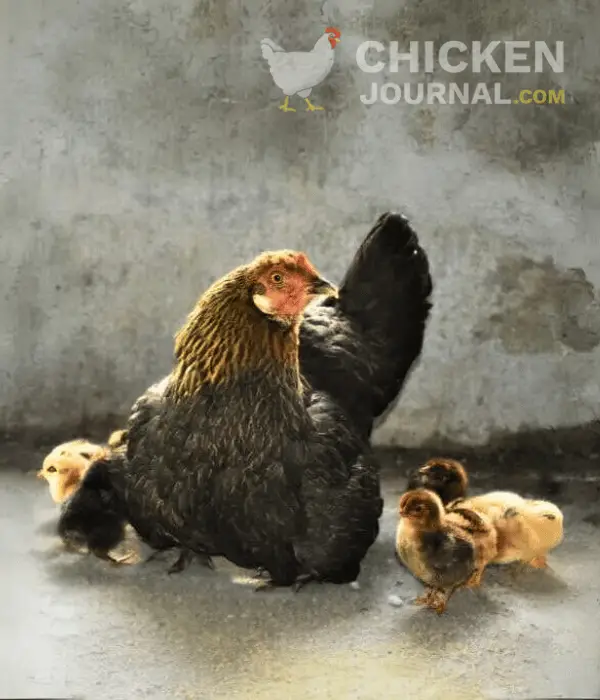
Brooding is vital for baby chick development. For growth, they need safety and warmth. It is a vital stage of the chicken life cycle.
Mother hens naturally provide brooding to their chicks by keeping them close and providing warmth with their feathers.
This natural behavior keeps chicks at the appropriate temperature for growing.
To protect baby chicks, modern poultry methods like artificial brooding are given.
Special brooders maintain controlled temperature and humidity.
This artificial brooding method provides for improved chick monitoring and environmental adaptation.
Brooding requires proper temperature. Baby chicks require outdoor warmth because they cannot keep their body warm.
The brooding area for the first week is 95–100 degrees Fahrenheit (35–37 degrees Celsius).
Young birds need warmth and security during brooding, but they must be protected against predators.
They need space, clean bedding, and good nutrition to grow well.
Also read: Brooding Chickens 101
Juvenile Stage: Pullet and Cockerel
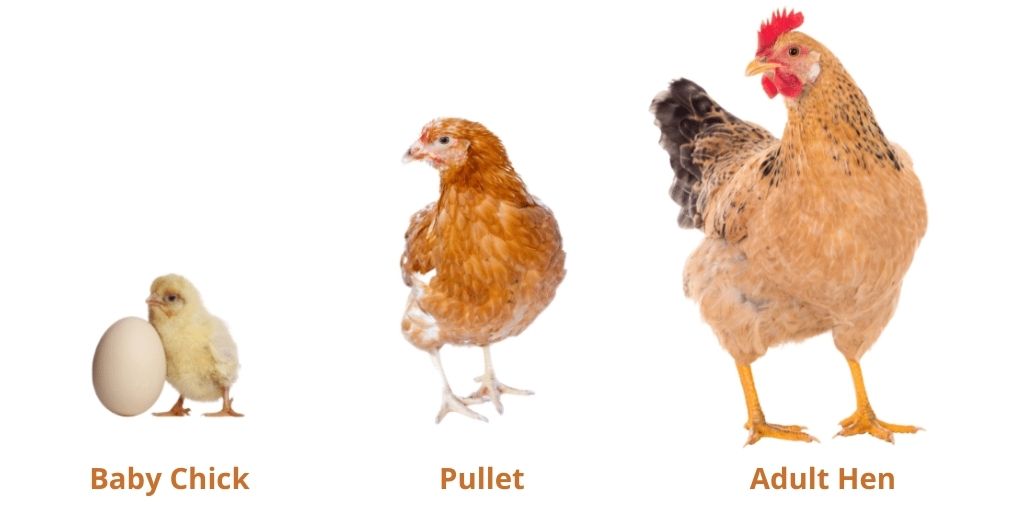
Chickens’ growth and development depend on their juvenile stage. As they mature, pullets and cockerels change significantly.
Cockerels are immature male chickens, while pullets are female. Both pullets and cockerels grow quickly as juveniles. Their bodies mature and show gender traits.
Pullets prepare for egg-laying by developing their reproductive organs. Cockerels have larger combs and wattles than pullets.
Chickens develop a sense of leadership within the flock (pecking order) during their juvenile age. They grow into their social roles and acquire new social skills.
Their socializing and interaction skills depend on this particular period. Healthy growth and development require adequate nutrition and care during this stage.
Their health depends on a balanced protein-mineral diet. When pullets and cockerels reach sexual maturity, they start breeding.
Adult Stage: Maturity and Reproduction in Chickens
Chicken adulthood is a crucial stage of the chicken life cycle. Chickens mature and are capable of reproduction at this time.
Chicken farmers and enthusiasts must know when birds are adults. This is when chickens are fully grown.
They’ve attained their breed-specific size and weight limit.
Hens are smaller and less colorful than adult roosters. Chicken reproduction is fascinating.
Roosters are essential to fertilization. Their testes and phallus help them transport sperm to hens during mating.
The reproductive system of hens is more complicated. They have two ovaries, but only the left works.
The oviduct transports an egg from the ovary to the infundibulum, magnum, isthmus, and shell gland.
After the sperm fertilizes the egg, it forms its shell. Hens lay completely developed eggs.
It happens every 24–26 hours, and hens can lay many eggs during their reproductive period.
Successful breeding and egg production requires knowledge of chicken development and reproduction.
Owners can keep chickens healthy and productive by feeding and caring for chickens.
Summary (Different Stages of The Chicken Life Cycle)
Understanding a chicken’s life cycle is fantastic and essential for its health.
Chickens experience changes from egg to chick to brooding, where they need warmth and shelter.
The pullet and cockerel stages are crucial for rapid development and learning, whereas the adult stage signifies maturity and reproduction.
These four stages demonstrate the purpose and adaptability of the chicken’s life cycle.
This knowledge will help you care for hens whether you like them.
I hope this guide helped you know about the various stages of the chicken life cycle.
